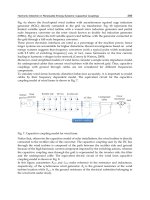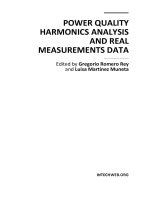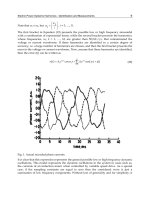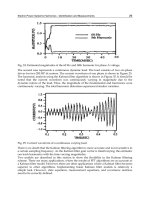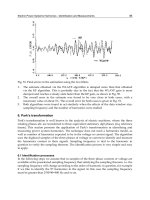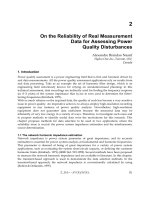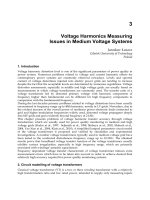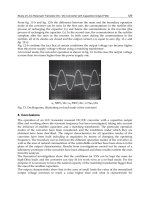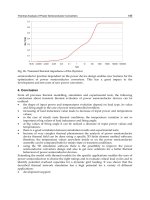Power Quality Harmonics Analysis and Real Measurements Data Part 12 docx
Bạn đang xem bản rút gọn của tài liệu. Xem và tải ngay bản đầy đủ của tài liệu tại đây (747.39 KB, 20 trang )
Part 4
Industrial Environments
9
Harmonics Effect in Industrial
and University Environments
M.H. Shwehdi
King Faisal University, College of Engineering, Al Ahsa,
Saudi Arabia
1. Introduction
1.1 Analyzing harmonic distortion produced from lead blast furnace (LBF)
A major cost to a steel factory facility is the energy used to power the arc furnace for the
melting and refining process. Operation at low power factor results in additional voltage
drop through the power system yielding a lower system voltage on the plant buses. Low
system voltage increases the melt time and will add to the overall plant operating costs per
ton. Low power factor can also result in additional costs in the form of penalties from the
electric-utility company [1-2, 8]. Capacitor can be applied in steel factory facilities for a wide
range of benefits. The capacitors will improve the power factor of the system; reduce billing
penalties imposed by the electric power utility, and increase system voltage-boosting
productivity. The system losses are also reduced improving the electrical system efficiency.
However, harmonic sources in the steel mill can interact with capacitor banks resulting in
problems if they are not properly applied. The effect of harmonics varies depending on the
type of load. In some cases such as a resistance heating load all of the applied voltage does
useful work; although, in most cases involving transformers and motors only the 60-Hz
component of the voltage does useful work and the harmonic component generates useless
heat. Sensitive electronic control circuits, timers, and logic circuits may be affected if the
supply voltage is distorted [3-5].
The harmonic current generated by any non-linear load flows from the load into the power
system. This current, seeking a low impedance path to ground, causes a voltage of the drop
through the system according to Ohm's Law. The harmonic voltage combines with the 60
Hz voltages producing a distorted power system voltage. The harmonic laden power system
voltage is then imposed on al1 of the remaining loads connected to the system this voltage
distortion may result in more harmonic currents being produced as other linear loads
experience the distorted system voltage.
A few industries like steel mills and aluminum smelters used electricity to power arc
furnaces, which distorted the waveform, because the current flow was not directly
proportional to the voltage. These loads are called non-linear loads. Non-linear loads cause
waveforms that are multiples of the normal 60 Hertz sine wave to be superimposed on the
base waveform. These multiples are called harmonics. Harmonic is defined as a sinusoidal
component of a periodic wave having a frequency that is an integral multiple of the
fundamental frequency. For example, the second harmonic is a 120 Hertz waveform (2 times
60 Hertz), the third is a 180 Hertz waveform, and so on.
Power Quality Harmonics Analysis and Real Measurements Data
212
Harmonic distortion may or may not create a problem for own facility. A plant may have
harmonics present, but experience no adverse effects. However, as harmonic levels increase,
the likelihood of experiencing problems also increases. Typical problems include:
Malfunctioning of microprocessor-based equipment
Overheating in neutral conductors, transformers, or induction motors
Deterioration or failure of power factor correction capacitors
Erratic operation of breakers and relays
Pronounced magnetic fields near transformers and switchgear
To make matters worse, harmonics can sometimes be transmitted from one facility back
through the utility's equipment to neighbouring businesses, especially if they share a
common transformer. This means harmonics generated in one facility can stress utility
equipment or cause problems in other neighbour’s facility and vice versa.
Electric utilities have recognized this problem and are adopting standards, like the Institute
of Electrical and Electronics Engineers (IEEE) Standard 519 which defines allowable
harmonic distortion at customer service entrances. This standard is designed to protect both
businesses and utilities, many other standards are also available and set limits for such
harmonic penetration.
Harmonic analysis, load flow analysis, and power factor correction in Metal Scrab plant in
Saudi Arabia, were considered for two reasons: 1) the planned installation of a new
Induction furnace; and 2) the correction of the overall plant power factor to a value above
0.90 lagging to eliminate utility penalties.
2. The behavior of electric arc furnace
The voltage across an electric arc, which is relatively independent of current magnitude,
consists of three components, anode drop, cathode drop and arc column component; which
amount to about 12 volts/cm of arc length.
Typical values of arc voltages are in the range of 150-500 volts. Since the arc is extinguished
at current zero, the power factor plays an important role on arc re-ignition. The figure 1.
shows how arc voltage, power factor, input power; arc power and reactive power vary with
arc current for a particular tap setting on the furnace transformer. The furnace is normally
operated near maximum arc power, which corresponds to a power factor of 70% [9].
Fig. 1. Electrical Characteristics of Electric Arc Furnace
Harmonics Effect in Industrial and University Environments
213
The three basic changes in operating states of an electric arc furnace, which can produce
distinguishable voltage disturbances on power system, are open circuit condition, short
circuit condition and the normal operation. The measurable data of interest for an electric
arc furnace load include the following three phase quantities: supply voltage, real and
reactive power, flicker, frequency and total harmonic distortion in respective phases.
Because of the non-linear resistance, an arc furnace acts as a source of current harmonics of
the second to seventh order, especially during the meltdown period. Voltage fluctuations
are produced in this way through impedance on the value of harmonic currents supplied
and the effective impedances at the harmonic frequencies. The harmonic current Iv of the
arc furnace forms a parallel tuned circuit consisting of capacitor C with reactive power and
mains inductance, resulting from the mains short circuit power. When this tuned circuit
resonates at a harmonic frequency, its reactance is high and a harmonic voltage arises,
which is damped by the resistance of the resistive component of the supply system
consumers’ equipment. The Q factor of this tuned circuit is low at times of full load, and no
resonant peaks occur. But in slack periods with combinations of low load with high
resistance and Q factor values, harmonic voltages are expected at levels sufficient to cause
appreciable interference [11].
3. Harmonic mitigation
Several methods of mitigating harmonics have been developed over the years. The most
common method is using filter, either passive or active. Passive filter block certain harmonic
bandwidth while active filter injects current into the system to cancel the current harmonic
waveforms. Both methods have their advantages and disadvantages, for example,
advantage of passive filter is easy to design and active filter can monitor many frequencies
simultaneously while disadvantage of passive filter is bulky in size and active filter is costly.
Harmonic filters are useful and practical to be implemented by consumer near the proximity
of the non-linear load at the low voltage system. Another method which is normally used by
consumers is using phase cancellation method using twelve pulse converters instead of six
pulse converters [12].
Similar application using filters for utility at higher voltage level such as distribution
network requires extensive economic consideration. This is due to the size and cost of the
equipment while most of harmonic pollutant is caused by consumer. There is little study on
a feasible and cost effective means for utility to mitigate harmonic, especially harmonic
voltage. A study was conducted on method using shunt harmonic impedance which can act
like a central damper to reduce harmonic at distribution network [13]. This method is
considered to be less expensive compared to active filter. The method uses power electronic
to emulate resistive behavior for harmonic. However, the method is still under further
study. Currently, all harmonic mitigation techniques involve equipment required to be
installed on the system. There is yet a study on using other factors which can affects
harmonic voltage distortion such as network impedance. Optimizing network impedance to
mitigate harmonic can be cost effective for utility to apply. Because of mitigating harmonic
is expensive, many utility company have resorted in imposing penalty to consumer for
injecting current harmonic above the standard steady state limit into the system. This
process requires method of determining harmonic contribution by the consumers and the
equipment need to be installed at all consumers’ feeder which is very costly[13].
Power Quality Harmonics Analysis and Real Measurements Data
214
4. Brief steel plant system description
The steel plant system consists of 49 buses and 38 two winding transformers. The plant is
fed from two utility substations at 230 KV and through four 230/34.5 KV transformers.
From 34.5 KV many 34.5/13.8 KV transformers are installed to feed difference load
including three electric Arc Furnaces (EAF1, EAF2, EAF3) and two Ladle Furnaces (LF1,
LF2). Part of The single line diagram of the arc furnaces of this system is shown in figure 2.
Fig. 2. Partial single line diagram of steel plant system.
This system was simulated by using a software package and the results of load flow, total
harmonic distortion, and power factor at some buses are shown in table 1.
Bus#
Nominal
Voltage (KV)
LF
Voltage
(p.u)
LF
Angle
(deg)
THD
(%)
Power
Factor
1 230.00 1.00 0.00 6.47 56
2 34.50 0.95 -1.90 10.31 59
3 34.50 0.95 -1.90 10.31 59
5 34.50 0.95 -1.90 10.30 59
45 0.48 0.91 -3.80 10.11 58
46 0.48 0.91 -3.80 10.11 58
Table 1. Load flow, THD, and power factor results
Filter Location Order Rated KV Kvar XL Q
Bus # 1 2
nd
230.00 35035.00 377.47 75.00
Bus # 5 5
th
34.50 30572.00 79.00 39.50
Bus # 5 7
th
34.50 24745.00 120.20 84.10
Table 2. Filtre Data
Flat Products
ELECTRICIT
Y
(SEC)
3x133 MVA
110 MVA 110 MVA
110
MVA
25 MVA
25 MVA
230 kV
34.5 kV
EAF 2
LF 1
LF 2 EAF 3
EAF 1
SVC 1
TCR=140
MVAR
FC=120 MVAR
SVC 2
TCR=160
MVAR
FC=110
MVAR
Harmonics Effect in Industrial and University Environments
215
Bus #
Nominal
Voltage
(KV)
LF Voltage
(p.u)
LF Angle
(deg)
THD
(%)
Pf
1 230.00 1.00 0.00 1.24 0.98
2 34.50 0.99 -2.30 2.95 0.99
3 34.50 0.99 -2.30 2.95 0.99
5 34.50 0.99 -2.30 2.95 0.99
45 0.48 0.95 -4.00 2.92 0.97
46 0.48 0.95 -4.10 2.92 0.97
Table 3. Load Flow, THD, and Power Factor Results
Single-tuned filters were designed for the metal plant system according to the next
paragraph theories and its input data are provided in table 2. The results of load flow, total
harmonic distortion, and power factor of buses 1, 2, 3, 5, 45, and 46 after installing filter are
shown in table 3. Also the spectrum and waveform of bus 34.5 kV is provided in figure 3.
Fig. 3. Spectrum of voltage at bus 34.5 kV
5. Filter design
Harmonic filters are designed to suppress system harmonics as well as to improve power
factor. They allow a system to meet IEEE Standard 519 harmonic limits while avoiding
power factor penalties. Filter designs are tailored to individual project objectives such as
meeting a harmonic limit and/or a power factor level. This is a complex and involved
engineering task, where alternative designs are checked to ensure that the final one will
meet study objectives [14].
Typically, single tuned shunt filters are designed with a reactor and capacitor in series,
connected as a shunt load on the system. In more complex studies, other types of filters, like
2nd or 3rd order, C-type, and/or double tuned filters are designed. In a complex filter design,
Power Quality Harmonics Analysis and Real Measurements Data
216
a combination of filter types could be required. A generic term used to describe those types of
equipment whose purpose is to reduce the harmonic current or voltage flowing in or being
impressed upon specific parts of an electrical power system, or both [4,11].
The filter is tuned slightly below the harmonic frequency of concern. This allows for
tolerances in the filter components and prevents the filter from acting as a direct short circuit
for the offending harmonic current. Further allows the filter to perform its function while
helping to reduce the duty on the filter components. It also minimizes the possibility of
dangerous harmonic resonance should the system parameters change and cause the tuning
frequency to shift slightly higher [6, 7].
Once the filter type and the components (reactors, capacitors and resistors) are determined,
the design program is used to model these filters. Overall power system operation can then
be analyzed to determine the effectiveness of the filtering scheme. Ratings of all filter
components along with the protection schemes and control methods are identified, and
detailed specifications are developed for the manufacture of the filters. All designs are based
on relevant IEEE Standards for capacitors and reactors [15].
5.1 Filtre components
5.1.1 Capacitors
Capacitors are composed of standard units that are connected in series or parallel for obtain
the desired overall voltage and KV rating [5]. The capacitor’s are designed and chosen with
the following considerations:
Harmonic current peaks have a 100% coincidence.
Nominal System over-voltage of 5%.
Ambient voltage distortion equal to the limits set forth by IEEE 519.
Adherence to IEEE/ANSI peak and RMS voltage ratings.
5.1.2 Inductors
Inductors used in filter circuit need to be designed bearing in mind the high frequencies
involved. Inductors rating depend mainly on the maximum RMS, current. The inductors
and resistors form the ground side of a tuned filter [5]. The reactor current ratings are based
on the following considerations:
The reactor core will not saturate for currents less than
250% of the fundamental current rating of the filter bank.
Peak flux density of the core will be less than 1.2 – 1.4
Tesla assuming all harmonic current peaks is 100% coincident.
5.2 Tuned filter
A single tuned filter is a series RLC circuit tuned to the frequency of one harmonic .its
impedance is given by
Z
1
=R + j (wL-1/wC) (5.1)
Which at the resonant frequency f
n
reduces to R. There are two basic design parameters to
be considered prior to the selection of R, L and C. these are the quality factor Q, and the
relative frequency deviations. It is generally more convenient to deal with admittances
rather than impedance in filter design
Harmonics Effect in Industrial and University Environments
217
Y
f
=1/R(1+j2s Q) =G
f
+ j B
f
(5.2)
Where
G
f
=Q/X0(1+4s
2
Q
2
) (5.3)
B
f
=2sQ
2
/X0(1+4s
2
Q
2
) (5.4)
X
0
=
L
C
(5.5)
The harmonic voltage at the filter bus bar is
V=I/Y
f
+Y
s
(5.6)
Therefore, to minimize the voltage distortion it is necessary to increase the overall
admittance of the filter in the parallel with the a.c system. The harmonic voltage increases
with (s) [4]. In term of Q and s can be equation (6) can be written as follows:
V=I{(Gs+1/R(1+4s
2
Q
2
))
2
+(Bs-2sQ/R(1+4s
2
Q
2
))
2
}
-1/2,
(5.7)
6. University Personnel Computers (PC) effect on line currents harmonics
6.1 Introduction
Power Quality problems are increasing with the proliferation of nonlinear devices, which
draw none sinusoidal current waveforms when supplied by a sinusoidal voltage source.
When these devices are present in an electric power system, they cause harmonic distortion
of voltages and currents. Individually, single phase nonlinear load may not pose many
serious harmonic problem, but large concentrations of these loads have the potential to raise
harmonic voltages and currents to unacceptable high levels which results in increased
neutral currents in four wire system, over heating of distribution system components and
may cause mechanical oscillations in generators and motors. Other unwanted effects are
capacitor and insulation failure due to harmonic resonance, malfunction of installed
protection systems, transient voltage fluctuations, over heating of system transformer and
cables, error of power electronic equipments operations and telephone interference.
Many desktop personal computers still present a nonlinear load to the AC supply. This is
because they have a power supply design known as a "capacitor input switch mode power
supply". Much of today’s Information Technology equipment including servers, routers,
hubs, and storage systems almost universally use a different power supply design known as
"Power Factor Corrected". These devices present a very linear load to the AC supply and do
not generate harmonic currents. In fact they are one of the cleanest loads on the power grid
and generate less harmonic current than many other devices such as fluorescent lighting or
variable speed drives. The 3
rd
harmonic currents, the predominant harmonic in PC power
supplies, causes overloaded neutrals, overheated transformers, and annoyance circuit
breaker tripping. Very high price may be spent on equipment which will either filter or
block the harmonics or withstand the heating effects of the harmonics.
Studies on the monitoring of power quality at computer sites have been conducted as early
as 1969, [16, -18], and continuing interest in this area has maintained regular publications
thereafter [19-21]. Most early studies were concerned with the effects of power disturbances
Power Quality Harmonics Analysis and Real Measurements Data
218
on the correct operation of the computer facility. However, with the advent of relatively
inexpensive personal computers (PC), the emphasis of computer power quality monitoring
has also moved towards investigating the effects that large concentrations of PCs can have
on other utility customers.
Personal computing impacts on power quality are increasing due to the common place
usage of switched mode power supplies (SMPS) for converting single phase AC into low
voltage DC for supplying processing electronics. Such power supplies, which are
responsible for the generation of odd line current harmonics, are the main concern of this
paper. However, in turn harmonically polluted line currents can distort supply voltages
causing power quality problems for other consumers connected at a point of common
coupling [22]. Additionally, and somewhat ironically, the switched mode power supply
itself can be affected by non-sinusoidal supply voltages [23], which can increase or decrease
current harmonics depending on the nature of the voltage distortion.
Switched mode power supplies are by no means restricted to PCs and can be found in a
variety of other widely used electrical equipment including low energy lighting, battery
chargers, televisions and their peripherals.
A recent study [24] has shown that the line current harmonics from a single PC differed
considerably to the harmonics generated collectively by several PCs of the same type. One
widely held theory [25] regarding this effect introduces the concepts of attenuation and
diversity. Attenuation describes the reduction in harmonic magnitude, and change in phase
angle, as a load connected to a SMPS increases, and attributes this effect to the change in the
spectrum of the line current pulse which widens to allow more power flow through the
SMPS. Attenuation is also observed where several identical loads share the same source
impedance. Diversity describes a The influence of personal computer processing modes on
line current harmonics similar effect where a reduction, or even cancellation, of harmonics is
possible due to loads of different levels, or connected through different impedances,
presenting differing phase angles to the supply. These findings have not been proved using
large-scale studies; although predictions based on results taken from individual computers
have been reported [26].
The primary aim of this investigation is to investigate how the mode of operation of a PC
affects the harmonics produced in the line current. This is an area barely mentioned in
previous literature although these effects are closely related. One published study has made
limited investigations of this type, but, again, only for individual computers [27]. In new
construction or renovation, many power disturbances can be prevented or significantly
lessened by designing for power quality assurance, at surprisingly small cost.
In view of the concerns regarding cumulative effects of large collections of PCs, this study
was conducted within a University library building containing over 370 PCs. Furthermore,
the study was intended to investigate the primary effect on line current harmonics caused
by mode of operation, in isolation from additional secondary effects caused by distorted
supply voltages. Investigation of this primary effect was achieved by monitoring during
periods when the PCs represented the only load on the transformer supplying the library
building and consequently the supply voltage waveforms were relatively undistorted. Most
of these disturbances originate right within the building. Personal computers, laser printers
and other switched-mode power supply equipment within your building are usually the
culprits for most of the power supply irregularities affecting other computers. It's a problem
Harmonics Effect in Industrial and University Environments
219
that has only recently begun to be recognized in the building industry, as more and more
computers and similar equipment are installed, turning the modern office or factory into a
high-tech computer environment. [28]
The objective of section six is to investigate the effect of an University-PC and other
harmonic contributing sources on the line currents that may have influence on processing
modes and to measure the actual Total Harmonic Distortion during such modes.
7. Power quality issues related to computers
Although harmonics is the subject of several international standards [16], the difficulties of
regulating harmonics emissions from small, individual devices employing switched mode
technology, such as a personal computer, is compounded by the fact that the harmonic
generation capabilities of these devices varies according to the number of parallel connected
devices.
In the last decade, power quality has become a major issue for electric utilities and their
customers, and indirectly to almost all manufacturers of equipment that depend on
sinusoidal supply voltage waveforms. The proliferation of solid-state switching devices in
both industry and home has increased the harmonic levels found on electricity supply
systems. In the past, sources of harmonics were limited and in most cases tolerable.
However today, virtually all high performance electronic equipment uses switched mode
power converters, conducting current for part of a cycle through multiple paths in order to
efficiently convert alternating current to direct current. In response to this increased demand
some countries encouraged the development of more efficient ways of getting full benefits
from electrical energy by various switching methods.
On the other hand a new technique of manufacturing circuits called integrated electronic
circuits have been invented and led directly to increasingly complex systems such as in
industry ,communications, domestic appliances … etc because its size, weight and cost.
These circuits, although increased speed of operations and complexity of tasks, typically use
a technique called switch mode power supplies [26- 29].
The majority of modern electronic units use switched mode power supplies (SMPS). The
advantage–to the equipment manufacturer– is the size, cost and weight is significantly
reduced and the power unit can be made in almost any required factor [28]. But
unfortunately switch mode power supplies act as non–liner loads or they can be considered
as a noise generators which get down the quality of the electricity supply.
Equipments with switch mode circuits are usually more sensitive to main variations and
disturbances than liner loads [30]. For this reason power quality has become a major issue
for electric utilities and their costumers and almost all manufactures of equipment that
despond on sinusoidal supply voltage waveforms. The increasing of solid state switch
devices such as Personal computers in both industry and homes will draw rather than
continuous current from the supply; the power supply unit will draw pluses of current
which contain large amount of harmonics [29, 32].
The switching mode power supplies used in personal computers are major sources of
harmonic currents. An experiment [26, 28, and 32] has been done for different types of
computers to measure the harmonic generated by each type and the result was scheduled
as:
Power Quality Harmonics Analysis and Real Measurements Data
220
Mac IIsi IBM XT IBM PS/30 Mac Plus IBM PS/70
I
1
106.82
(
100%
)
165.93
(
100%
)
199.02
(
100%
)
83.35
(
100%
)
541.88
(
100%
)
I
3
89.31
(83.6%).
122.45
(73.8%)
152.63
(76.7%)
72.30
(86.7%)
458.83
(84.7%)
I
5
65.18
(
61.0%
)
68.03
(
41.0%
)
94.76
(
47. 6%
)
55.80
(
66.9%
)
333.54
(
61.5%
)
I
7
40.51
(37 .9%)
26.71
(16.1%)
39.16
(19.7%)
36.53
(43.8%)
192.04
(35.4%)
I
9
21.25
(19.9%)
5.64
(3.4%)
10.39
(5.2%)
17.78
(21.3%)
71.18
(13.1%)
I
11
8.70
(
8.1%
)
3.98
(
2 .4%
)
3.53
(
1.8%
)
3.31
(
4.0%
)
17.75
(
3 .3%
)
I
13
2.95
(2 .8%)
8.46
(5 .1%)
1.49
(0. 7%)
4.95
(5. 9%)
49.02
(9.0%)
I
15
3.46
(
3.2%
)
8.29
(
5. 0%
)
2.30
(
1.1%
)
7.51
(
9.0%
)
48.01
(
8.8%
)
Table 4. Magnitudes of harmonic currents of various PC’s in mA [32]
The phase current is given by:
222222 2 2
13579111315P
I IIIIII I I
(6.1)
The IBM XT™ has the lowest percent third harmonic current (74%). Since the computer is
connected line-to-neutral in a 3-phase system, the neutral current is approximately equal to
three times the vector sum of the third and ninth harmonic currents flowing in each phase.
22
39
3 367,764
n
III mA
(6.2)
219,226
P
ImA
(6.3)
1,677
n
P
I
I
(6.4)
The Mac Plus
TM
offers the worst case third harmonic current (87%). In a similar manner I
n
&
I
p
are obtained.
223,377
n
I
(6.5)
130,507
P
ImA
(6.6)
1,712
n
p
I
I
(6.7)
With a large number of personal computer loads, the neutral current is expected to be 1.7
times the phase current. It will certainly overload the neutral conductor that is designed to
handle lower currents than the phase currents [14]. Non linear loads connected to a
sinusoidal source inject harmonic currents into the source. Much attention has been focused
Harmonics Effect in Industrial and University Environments
221
on large power converters as sources of harmonics due to the high magnitude of the
currents evolved. Nevertheless, harmonics generated by low power converters become
significant when large numbers of converters are used simultaneously [14, 15]. Indubitably
the personal computer is an ideal place for these converters. The power supplies employed
in most personal computers are of the switching mode type. In switching mode power
supply, the 60 Hz AC voltage is converted to into DC through a single phase rectifier and
the output voltage of the rectifier is stepped down using AC to DC converter [13, 14]. The
main advantage of the switching mode power supply over the traditional linear power
supply is its high energy efficiency since the switching elements used (BJT’s, MOSFETS) are
either completely off or completely on.
Personal computers impacts on power quality are noticeable due to the common place usage
of switched mode power supplies (SMPS) for supplying processing electronics. Such power
supplies are responsible for the generation of odd line current harmonics. However, in turn
harmonically polluted line currents can distort supply voltages causing power quality
problems for other consumers connected at a point of common coupling (PCC). Switched
mode power supplies are by no means restricted to PCs and can be found in a variety of
other widely used electrical equipment including low energy lighting, battery chargers,
televisions and their peripherals. For power quality considerations, the PC is the most
significant item for a variety of reasons including.
On an individual basis, it represents one of the larger loads consuming typically 200-300
W per unit.
The current drawn is affected by user behavior.
Large numbers of PCs can be connected to a single supply point.
The last point is one of the major concerns of increasing PC usage and has resulted in power
quality studies of the cumulative effects of many PCs connected to the same bus bar [27]. A
recent study has shown that the line current harmonics from a single PC differed considerably
to the harmonics generated collectively by several PCs of the same type. One widely held
theory regarding this effect introduces the concepts of attenuation and diversity [25].
Attenuation describes the reduction in harmonic magnitude, and change in phase angle, as
load connected to a SMPS increases due to the change in spectrum of the line current pulse
which widens to allow more power flow through the SMPS. Attenuation is also observed
where several identical loads share the same impedance. Diversity describes a similar effect
where a reduction or even cancellation of harmonics is possible due to loads of different
levels, or connected through different impedances, presenting differing phase angles to the
supply. These findings have not been proved using large scale studies [25-28].
8. Study proceedures and results
8.1 Introduction
The University consists consists of 60 buildings including students housing. Almost each
student at the university has a laptop regardless of the number of PC’s in each, laboratories,
or rooms. The university in-house that there are around 6000 PCs distributed unequally .
Most of the PS's in the university are of model HP, DELL, Compaq dc 7800P; they use Intel
core 2 Dual processors.
8.2 Measurement plan
This investigation adapted the following steps which include:
Obtaining all line diagrams of the area of investigation.
Power Quality Harmonics Analysis and Real Measurements Data
222
Securing the total number of the university PC's and most PC’s concentration area.
Circulate Questionnaire to major PC users such as ITC to develop a sense where are the
major area that may have harmonics as to affect ITC line currents and servers etc…
Locate and prepare the building (14, consist of 263 PC’s and 58 consist of 280 PC’s)
switchboard to be able to conduct different measurements being the highest building
containing PC’s.
Conduct Harmonic measurements at these buildings and monitor and check harmonics
at different loading processing modes and times.
Recommendation and findings are to be clearly drawn out of results and stressing the
mode of operations and size of PC lab.
Identify the sources and causes of harmonics at such selected locations: use such data in
the process of making the appropriate mitigating actions.
To conduct harmonic measurement the team members attended intensive lectures and
training on Power Quality and measurements. Training focused on how to use the power
quality analyzer (PQA).
Single line diagrams for each of the building under investigate were obtained as shown in
Figure 4. Permissions to conduct measurement and open switch boards of the different
feeders were also obtained through the university Electrical Maintenance department.
The whole Excl file containing total PC’s provided by from ITC indicating all the university
PC’s record and their distributions at the different building and labs etc…The total February
2009 PC’s numbers was 6,344.00.
Fig. 4. Building 14 Single Line Diagram and Points of Measurements and switch boards
Harmonics Effect in Industrial and University Environments
223
8.3 Measurements at normal load
The measurements have been conducted by the team members of the project according to
the following time Table:
Day
Reading #1
period
Reading #2
period
Reading #3
period
location inside the
substation
Monday
9:00AM-
12:00Pm
12:10Pm-
1:30PM
1:40PM-4:00PM At point 1*
Tuesday
9:00AM-
12:00Pm
12:10Pm-
1:30PM
1:40PM-4:00PM At point 2**
Wednesday
9:00AM-
12:00Pm
12:10Pm-
1:30PM
1:40PM-4:00PM At point 3***
*indicates the point between MPD2 &the transformer 380/208 v
**indicates the point between UPS &the transformer 480/380 v
***indicates the point between EPDP & the main feeder 3ф-4w 480v
Table 5. Time table of measurements
At the first point shown in the single line diagram (Figure 4), three measurements have been
conducted over the three periods as listed in table 5.
8.4 Measurements and results
The measurement of the harmonics caused by PC’s and any other nonlinear elements were
conducted at each bus (points 1, 2, and 3) as indicated in the single line diagram.
At the first point shown in the single line diagram (Figure 4), three measurements have been
conducted over three periods. The THD during the first period at point one was measured
and the maximum total harmonic distortion (THD) was 10.6%. The THD during the second
period at point one and the maximum total harmonic distortion (THD) was 10.7%. The THD
during the third period at point one and the maximum total harmonic distortion (THD) is
10.8%
From the previous three readings it is clear that at normal load at point one the maximum
total harmonic distortion of the three readings is 10.8%. Moreover, the harmonics effect
appears in the current waveform as in Figure 5.
For the second point the THD during the first period indicated a maximum total harmonic
distortion (THD) was 29%.
On the second measuring period the THD during the second period at point one and the
maximum total harmonic distortion (THD) was 28.4%. The THD during the third time
period at point two indicated maximum total harmonic distortion (THD) of 28.9%. From the
previous three readings it is clear that at normal load at point two increases the harmonic
flow, the maximum total harmonic distortion of the three readings is 28.9%. Moreover, the
harmonics appears to distort the phase current waveform as in Figure 6.
Power Quality Harmonics Analysis and Real Measurements Data
224
Fig. 5. Current wave forms at point one
The sum of all these THD’s = 83.8% is not equal the THD at point one which is 10.8%.The
difference between these two values explains which is called harmonic cancellations. The
phase angles of the magnetization current harmonics oppose the phase angles of the load
current harmonics and such lead to harmonic cancellations. The maximum total harmonic
distortion at point three is 20.6% which is less than that at point two (29%).The difference
between the two values is caused also by harmonics cancellation. According to the
instructions provided with the power quality analyzer manual and other standards which
state that if the current THD is less than 20% the harmonic distortion is probably acceptable,
the total harmonic distortion at point three (29%) was greater than 20%, so it is not
acceptable and definitely will make adverse affect on the neutral line cable.
Harmonics Effect in Industrial and University Environments
225
Fig. 6. Current wave forms at point two
To avoid the injection of harmonics into the system, a harmonic filter must be designed to
eliminate the highest harmonics order flowing and then installed at the near bus of such
produced harmonic. It is noticed in table 6 that the highest THD measured was during the
period where students were using laboratories of Building 14 at point 2 with the highest
harmonic is of fifth order. While table 7 illustrates harmonics produced as to the total
numbers of Pc’s used.
Power Quality Harmonics Analysis and Real Measurements Data
226
Location
Max THD
in the first
period
Max THD
in the
second
period
Max THD
in the third
period
Crest
Factor
Highest
Harmonic
Order
Point 1 10.6% 10.7% 10.8% 1.5-1.6 Third
Point 2 29% 28.4% 28.9% 1.5 Fifth
Point 3 19.6% 19.9% 20.6% 1.5 Fifth
Table 6. Summary of the obtained results for the three points of Bldg. 14
No.
of
PC’s
%age
Mag.
of 3
rd
Harmonic
%age
Mag.
of 5
th
Harmonic
%age
Mag.
of 7
th
Harmonic
%age
Mag.
of 9
th
Harmonic
%age
Mag.
of 11
th
Harmonic
%age
Mag.
of 13
th
Harmonic
%age
Mag.
of 15
th
Harmonic
%age
Mag.
of 17
th
Harmonic
THD
%
263 28.3A 14.8A 5.2A 0.4A 0.7A 0.1A 0.4A 0.1A 10.4
204 27.1A 13.1A 4.6A 1.4A 0.7A 0.4A 0.7A 0.1A 9.9
170 25.6A 12.5A 4.2A 1.8A 0.8A 0.4A 0.5A 0.1A 9.6
Table 7. Harmonic magnitudes for different No. of PC’s at point 1
8.5 Standards and limits
International Standards have set some limits to the most equipment on the permissible
harmonic content in the electrical system during operation. The following are general limits
for various electrical equipments:
a. Synchronous machine: permissible stator current distortion < 1.4%
b. Asynchronous machines: permissible stator current distortion; 1.5% to 3.5%
c. Cable: permissible core-shielding voltage distortion < 10%
d. Electronic equipment: 5% voltage distortion with a maximum individual percentage of
3% depending on the equipment
e. Transformer: permissible current distortion <5% at full load [ IEEE-519 ]
Most utilities have adopted standards to limit the harmonic content at the point of common
coupling (PCC). Some of the Standards adapted around the world include:
US/Canada IEEE 519
Europe IEC61000 3-2, 3-4
United Kingdom G5/4 -1
China GB/T 14549
9. Thd theory and verification calaculations
The percentage of Total Harmonic Distortion (%THD) can be defined in two different ways,
as a percentage of the fundamental component (the IEEE definition of THD) or as a
percentage of the RMS (used by the Canadian Standards Association and the IEC).
THD =
2
2
1
,
n
Irms n
I
(9.1)
Harmonics Effect in Industrial and University Environments
227
Where, I
rms, n
is the amplitude of the harmonic component of order n (i.e., the nth harmonic).
The numerator gives the RMS current due to all harmonics and I
1
is the RMS value of
fundamental component of current only. Given above is the mathematical form of the IEEE.
According to IEC standards, the mathematical form of THD is given below:
THD =
2
2
1
,
n
Irms n
I
(9.2)
Where
I
rms
=
2
1n
Irms
(9.3)
Where I
rms, n
is the amplitude of the harmonic component of order n (i.e., the nth harmonic)
and I
rms
is the rms value of all the harmonics plus the fundamental component of the
current. The later standard is referred in this study, because the apparatus used for analysis
was based on IEC Standards.
The 3rd, 5th, 7th and 9th harmonics being the most significant, the definition of THD may be
modified and written as in 9.4
THD =
2222
,3 ,5 ,7 ,9Irms Irms Irms Irms
Irms
(9.4)
The value of THD may be calculated for any number of computers using formula (9.3).
I
rms
= 308.4 A
RMS magnitude of 3rd Harmonic= 25.6 A
RMS magnitude of 5th Harmonic= 12.5 A
RMS magnitude of 7th Harmonic= 4.2 A
RMS magnitude of 9th Harmonic= 1.8 A
THD =
2222
25,6 12,5 4, 2 1,8
308,4
= 9.36% (9.5)
Figure 9 is showing the magnitude of individual harmonics, when 263 PCs in building 14
were connected to the supply mains.
Fig. 7. Harmonic spectrums at point one when 263 PC’s operating
Power Quality Harmonics Analysis and Real Measurements Data
228
The online value of THD was 9.6%. The percentage difference (Error) of the calculated and
experimental value is 0.24%.
This difference caused by neglecting other odd harmonics such small error proves the
validity of measurement using this PQA and it consequently plays a pivotal role for the
accurate analysis of the odd harmonics.
Figure 8 explains the overall impact of individual harmonics cumulatively. Total Harmonic
Distortion (THD) in line current is increasing when the electronic loads are increasing.
Among odd harmonics only third harmonic plays active role whereas the other odd
harmonics impact with increase in electronic loads is negligible.
By using linear interpolation, the relation between THD in current and the number of PC’s
(N) is given by the following equation:
I
t
= 8.143 + 0.008 x N (9.6)
Fig. 8. THD curve vs. No. of PC’s at point 1.
Fig. 9. Harmonic spectrums at point 2 when 263 PC’s operating
The value of THD may be calculated for any number of computers with formula (9.4).
Figure 9 is showing the magnitude of individual harmonics, when 263 PCs were connected
to the supply mains.
I
rms
= 2271 A
RMS magnitude of 3rd Harmonic= 3 A
